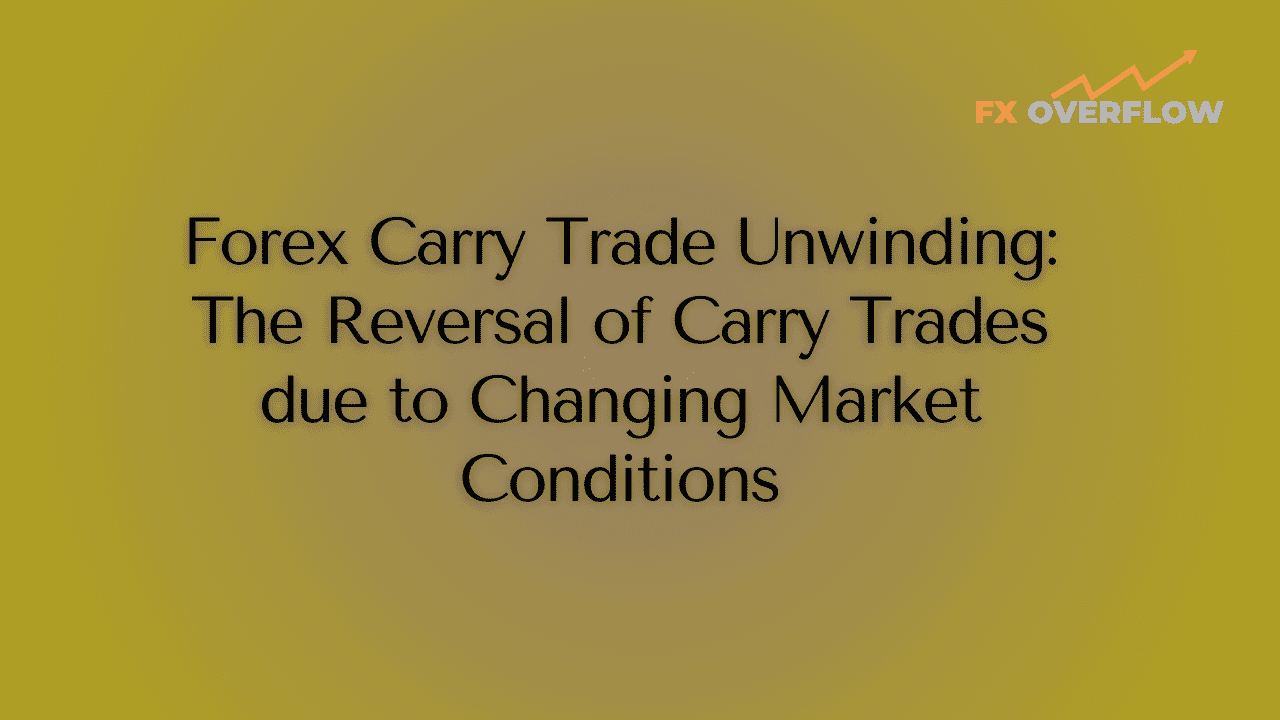Forex Carry Trade Unwinding: The Reversal of Carry Trades due to Changing Market Conditions
In the world of forex trading, carry trades have long been a popular strategy for investors seeking to capitalize on interest rate differentials between currencies. These trades involve borrowing money in a low-interest rate currency and investing it in a higher-interest rate currency, generating profit from the interest rate spread. However, like any investment strategy, carry trades are not without risks, and changing market conditions can lead to a phenomenon known as "forex carry trade unwinding." In this article, we will explore the concept of carry trade unwinding, its causes, and its impact on the forex market.
Table Content
1. Understanding Carry Trades
2. The Allure of Carry Trades
3. Causes of Carry Trade Unwinding
4. Impact on Forex Markets
5. Footnote
Understanding Carry Trades
Before delving into carry trade unwinding, it is essential to grasp the basic principles of carry trades. In a carry trade, an investor borrows funds in a currency with a low-interest rate, typically from a country with a stable economy, and then converts those funds into a currency with a higher interest rate. The investor will then invest in assets denominated in the higher-interest rate currency, such as bonds or other financial instruments.

The profit in a carry trade arises from the difference between the interest rates of the two currencies. As long as the exchange rate remains stable or moves in favor of the investor, the carry trade can be profitable. Traders often hold these positions for an extended period to take advantage of the interest rate differential, aiming to generate steady returns over time.
The Allure of Carry Trades
Carry trades have been favored by investors due to the potential for consistent returns and relative stability compared to other trading strategies. In times of low market volatility and stable economic conditions, carry trades can offer a steady income stream, attracting institutional investors and individual traders alike.
Furthermore, central banks' monetary policies play a crucial role in the profitability of carry trades. When central banks in higher-interest rate countries adopt a hawkish stance and raise interest rates, the appeal of carry trades grows stronger, as the interest rate differential widens.
Causes of Carry Trade Unwinding
The allure of carry trades can quickly diminish when market conditions change, leading to carry trade unwinding. Several factors contribute to this phenomenon:
1. Shifts in Interest Rates
One of the primary drivers of carry trade unwinding is a shift in interest rates. If a central bank in the higher-interest rate country decides to lower its rates or adopts a dovish monetary policy, the interest rate differential narrows, reducing the potential profit of the carry trade. This prompts traders to unwind their carry positions and seek better opportunities elsewhere.
2. Economic and Political Instability
Forex markets are highly sensitive to economic and political developments. If a country experiences economic downturns, political uncertainty, or unexpected events, investors may rush to exit their carry trades, fearing potential losses. This sudden mass unwinding of positions can lead to significant volatility in the forex market.
3. Market Sentiment and Risk Aversion
Investor sentiment plays a crucial role in carry trade unwinding. During periods of heightened market risk and risk aversion, investors tend to favor safer assets, such as the low-interest rate currencies used in carry trades. This can lead to a rapid unwinding of carry positions, amplifying market turbulence.
4. Speculative Bubbles
In some cases, carry trades can contribute to the formation of speculative bubbles in certain currencies. When speculative fervor builds up around a particular carry trade, it can lead to an unsustainable influx of capital into that currency. Once the bubble bursts, traders rush to exit their positions, causing a swift unwinding of carry trades.
Impact on Forex Markets
Carry trade unwinding can have a significant impact on the forex market, leading to heightened volatility and sharp fluctuations in exchange rates. When a considerable number of investors unwind their carry trades simultaneously, it can create cascading effects on multiple currencies and asset classes.
During periods of carry trade unwinding, emerging market currencies, which are often involved in carry trades, tend to experience the most substantial losses. Additionally, currencies from countries with weaker economic fundamentals may also suffer as investors seek safer assets.
Central banks and financial authorities closely monitor carry trade activities and may intervene in extreme situations to stabilize their currencies and prevent excessive volatility.
Footnote
In Summary, forex carry trade unwinding is a phenomenon that occurs when changing market conditions prompt investors to exit their carry trade positions. Factors such as shifts in interest rates, economic and political instability, market sentiment, and speculative bubbles can all contribute to the unwinding of carry trades. When carry trades are unwound en masse, it can result in significant volatility in the forex market, affecting various currencies and asset classes.
As with any investment strategy, carry trades carry inherent risks, and investors should approach them with caution, considering the prevailing economic and geopolitical landscape. To navigate the ever-changing forex market successfully, traders must stay vigilant, diversify their portfolios, and stay informed about global economic developments and central bank policies. Only then can they make informed decisions to optimize their trading strategies and adapt to evolving market conditions.











Discussion